Organisational Behaviour: Structure, Culture, and Leadership Analysis
VerifiedAdded on 2020/07/22
|18
|6507
|58
Report
AI Summary
This report provides a comprehensive analysis of organisational behaviour, comparing the structures and cultures of CAPCO and Ernst & Young. It examines the impact of these elements on organisational performance and growth, as well as the factors influencing individual behaviour within a workplace. The report further explores various leadership styles, contrasting their effectiveness across different organisations and delving into the impact of organisational theories on management practices. It also evaluates different management approaches, analyses the impacts of leadership styles on motivation, and compares the application of motivational theories. Moreover, it emphasizes the importance for managers to understand and apply motivational theories. Finally, it discusses the nature of group and group behaviour, the factors that promote or inhibit effective teamwork, and the impact of technology on team functioning. The report concludes by highlighting key findings and implications for effective management and organizational success.
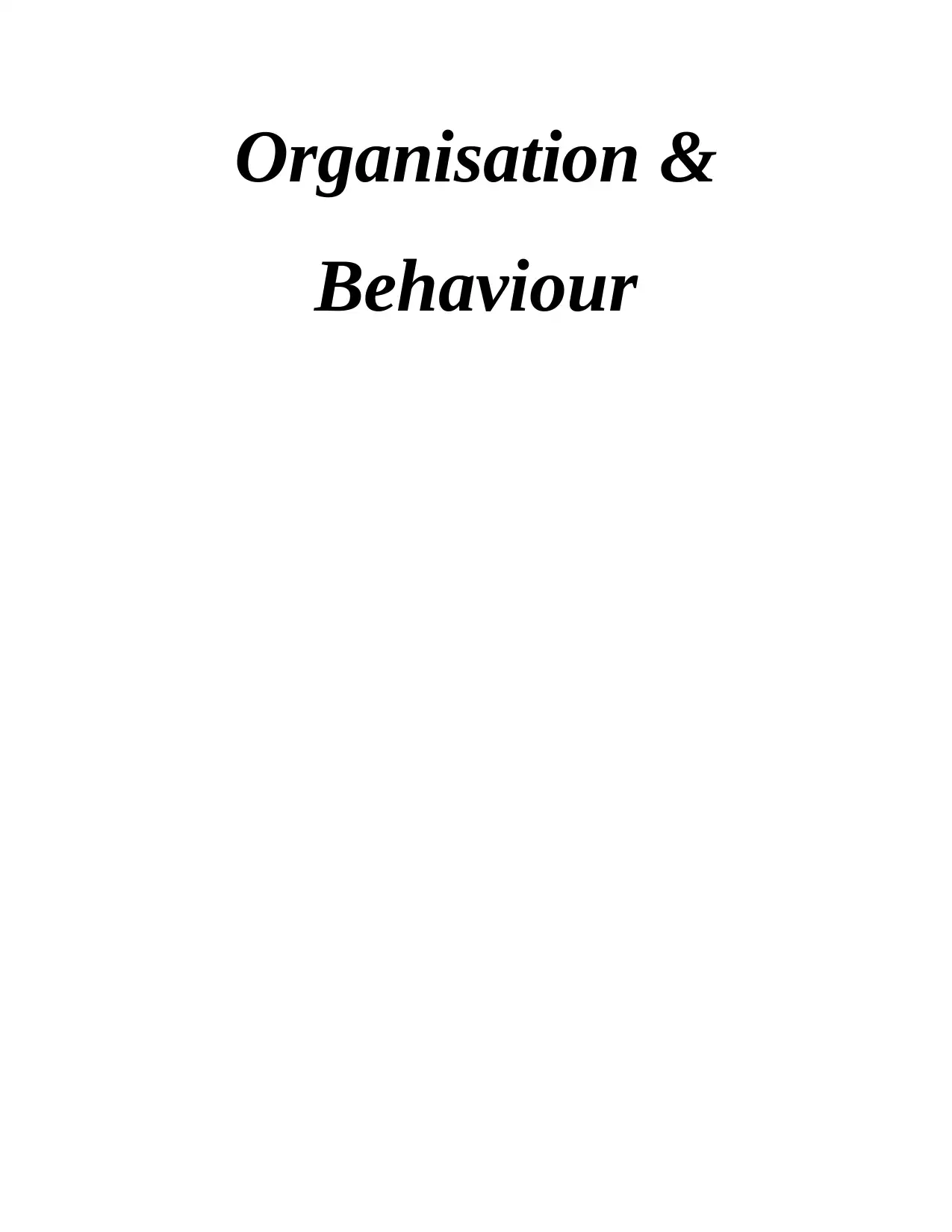
Organisation &
Behaviour
Behaviour
Paraphrase This Document
Need a fresh take? Get an instant paraphrase of this document with our AI Paraphraser
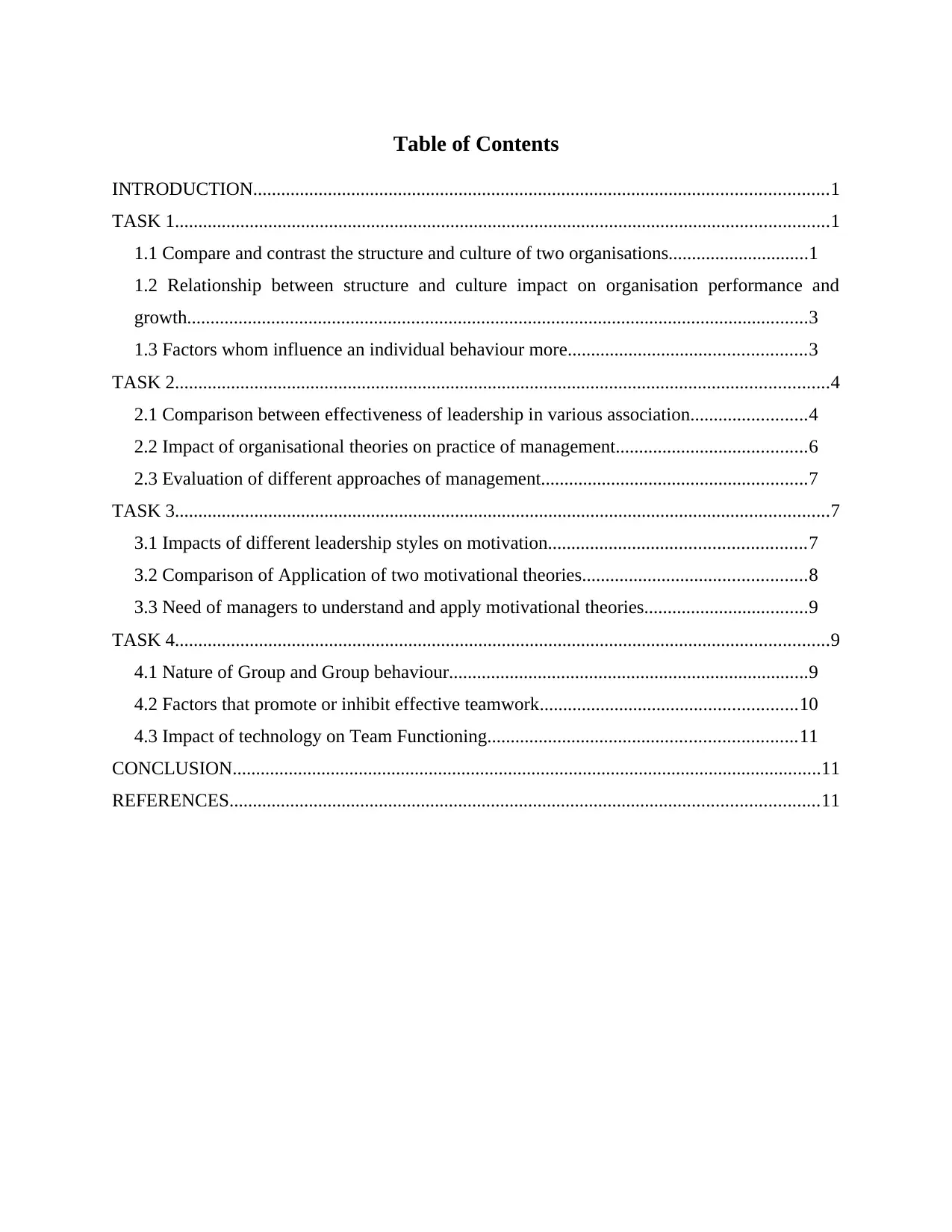
Table of Contents
INTRODUCTION...........................................................................................................................1
TASK 1............................................................................................................................................1
1.1 Compare and contrast the structure and culture of two organisations..............................1
1.2 Relationship between structure and culture impact on organisation performance and
growth.....................................................................................................................................3
1.3 Factors whom influence an individual behaviour more...................................................3
TASK 2............................................................................................................................................4
2.1 Comparison between effectiveness of leadership in various association.........................4
2.2 Impact of organisational theories on practice of management.........................................6
2.3 Evaluation of different approaches of management.........................................................7
TASK 3............................................................................................................................................7
3.1 Impacts of different leadership styles on motivation.......................................................7
3.2 Comparison of Application of two motivational theories................................................8
3.3 Need of managers to understand and apply motivational theories...................................9
TASK 4............................................................................................................................................9
4.1 Nature of Group and Group behaviour.............................................................................9
4.2 Factors that promote or inhibit effective teamwork.......................................................10
4.3 Impact of technology on Team Functioning..................................................................11
CONCLUSION..............................................................................................................................11
REFERENCES..............................................................................................................................11
INTRODUCTION...........................................................................................................................1
TASK 1............................................................................................................................................1
1.1 Compare and contrast the structure and culture of two organisations..............................1
1.2 Relationship between structure and culture impact on organisation performance and
growth.....................................................................................................................................3
1.3 Factors whom influence an individual behaviour more...................................................3
TASK 2............................................................................................................................................4
2.1 Comparison between effectiveness of leadership in various association.........................4
2.2 Impact of organisational theories on practice of management.........................................6
2.3 Evaluation of different approaches of management.........................................................7
TASK 3............................................................................................................................................7
3.1 Impacts of different leadership styles on motivation.......................................................7
3.2 Comparison of Application of two motivational theories................................................8
3.3 Need of managers to understand and apply motivational theories...................................9
TASK 4............................................................................................................................................9
4.1 Nature of Group and Group behaviour.............................................................................9
4.2 Factors that promote or inhibit effective teamwork.......................................................10
4.3 Impact of technology on Team Functioning..................................................................11
CONCLUSION..............................................................................................................................11
REFERENCES..............................................................................................................................11
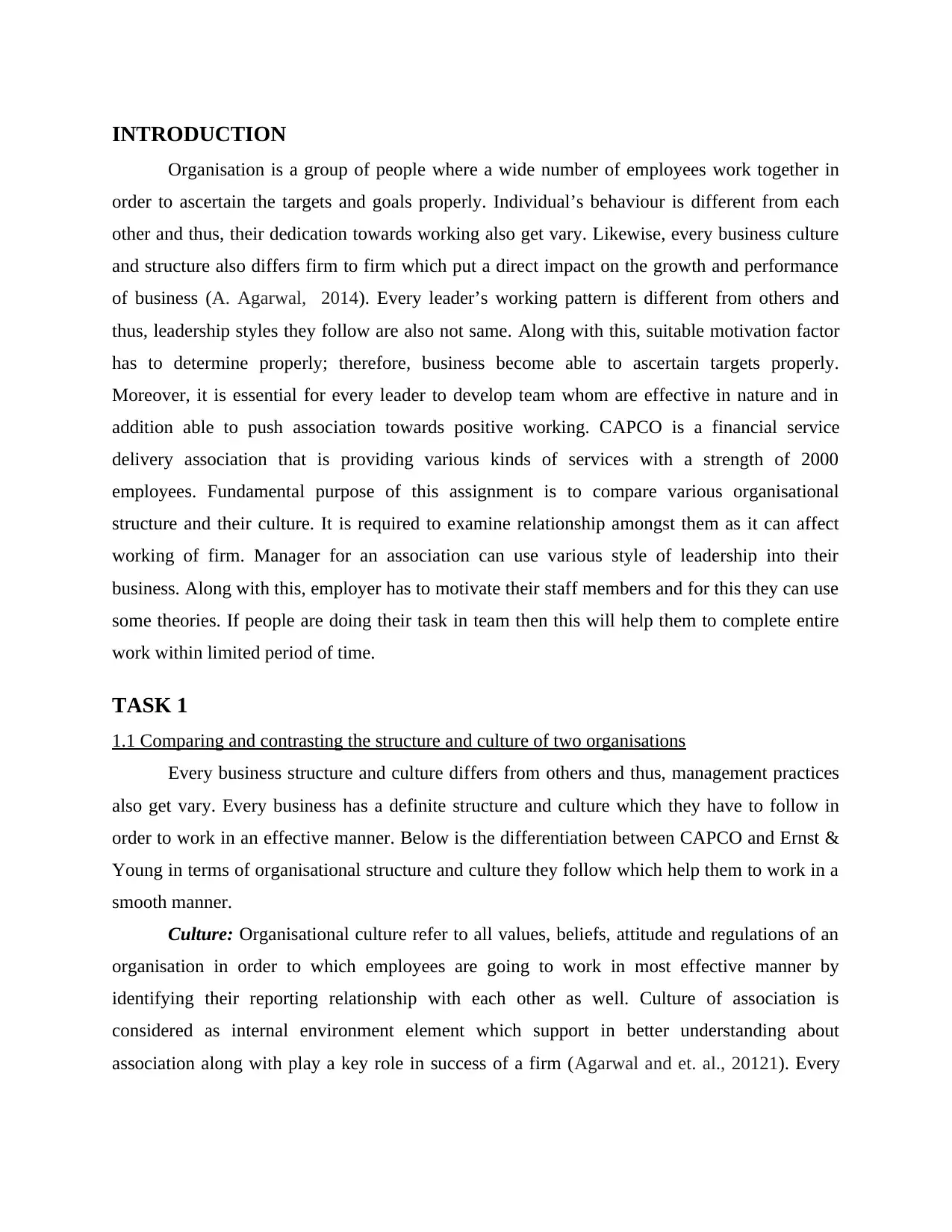
INTRODUCTION
Organisation is a group of people where a wide number of employees work together in
order to ascertain the targets and goals properly. Individual’s behaviour is different from each
other and thus, their dedication towards working also get vary. Likewise, every business culture
and structure also differs firm to firm which put a direct impact on the growth and performance
of business (A. Agarwal, 2014). Every leader’s working pattern is different from others and
thus, leadership styles they follow are also not same. Along with this, suitable motivation factor
has to determine properly; therefore, business become able to ascertain targets properly.
Moreover, it is essential for every leader to develop team whom are effective in nature and in
addition able to push association towards positive working. CAPCO is a financial service
delivery association that is providing various kinds of services with a strength of 2000
employees. Fundamental purpose of this assignment is to compare various organisational
structure and their culture. It is required to examine relationship amongst them as it can affect
working of firm. Manager for an association can use various style of leadership into their
business. Along with this, employer has to motivate their staff members and for this they can use
some theories. If people are doing their task in team then this will help them to complete entire
work within limited period of time.
TASK 1
1.1 Comparing and contrasting the structure and culture of two organisations
Every business structure and culture differs from others and thus, management practices
also get vary. Every business has a definite structure and culture which they have to follow in
order to work in an effective manner. Below is the differentiation between CAPCO and Ernst &
Young in terms of organisational structure and culture they follow which help them to work in a
smooth manner.
Culture: Organisational culture refer to all values, beliefs, attitude and regulations of an
organisation in order to which employees are going to work in most effective manner by
identifying their reporting relationship with each other as well. Culture of association is
considered as internal environment element which support in better understanding about
association along with play a key role in success of a firm (Agarwal and et. al., 20121). Every
Organisation is a group of people where a wide number of employees work together in
order to ascertain the targets and goals properly. Individual’s behaviour is different from each
other and thus, their dedication towards working also get vary. Likewise, every business culture
and structure also differs firm to firm which put a direct impact on the growth and performance
of business (A. Agarwal, 2014). Every leader’s working pattern is different from others and
thus, leadership styles they follow are also not same. Along with this, suitable motivation factor
has to determine properly; therefore, business become able to ascertain targets properly.
Moreover, it is essential for every leader to develop team whom are effective in nature and in
addition able to push association towards positive working. CAPCO is a financial service
delivery association that is providing various kinds of services with a strength of 2000
employees. Fundamental purpose of this assignment is to compare various organisational
structure and their culture. It is required to examine relationship amongst them as it can affect
working of firm. Manager for an association can use various style of leadership into their
business. Along with this, employer has to motivate their staff members and for this they can use
some theories. If people are doing their task in team then this will help them to complete entire
work within limited period of time.
TASK 1
1.1 Comparing and contrasting the structure and culture of two organisations
Every business structure and culture differs from others and thus, management practices
also get vary. Every business has a definite structure and culture which they have to follow in
order to work in an effective manner. Below is the differentiation between CAPCO and Ernst &
Young in terms of organisational structure and culture they follow which help them to work in a
smooth manner.
Culture: Organisational culture refer to all values, beliefs, attitude and regulations of an
organisation in order to which employees are going to work in most effective manner by
identifying their reporting relationship with each other as well. Culture of association is
considered as internal environment element which support in better understanding about
association along with play a key role in success of a firm (Agarwal and et. al., 20121). Every
⊘ This is a preview!⊘
Do you want full access?
Subscribe today to unlock all pages.

Trusted by 1+ million students worldwide
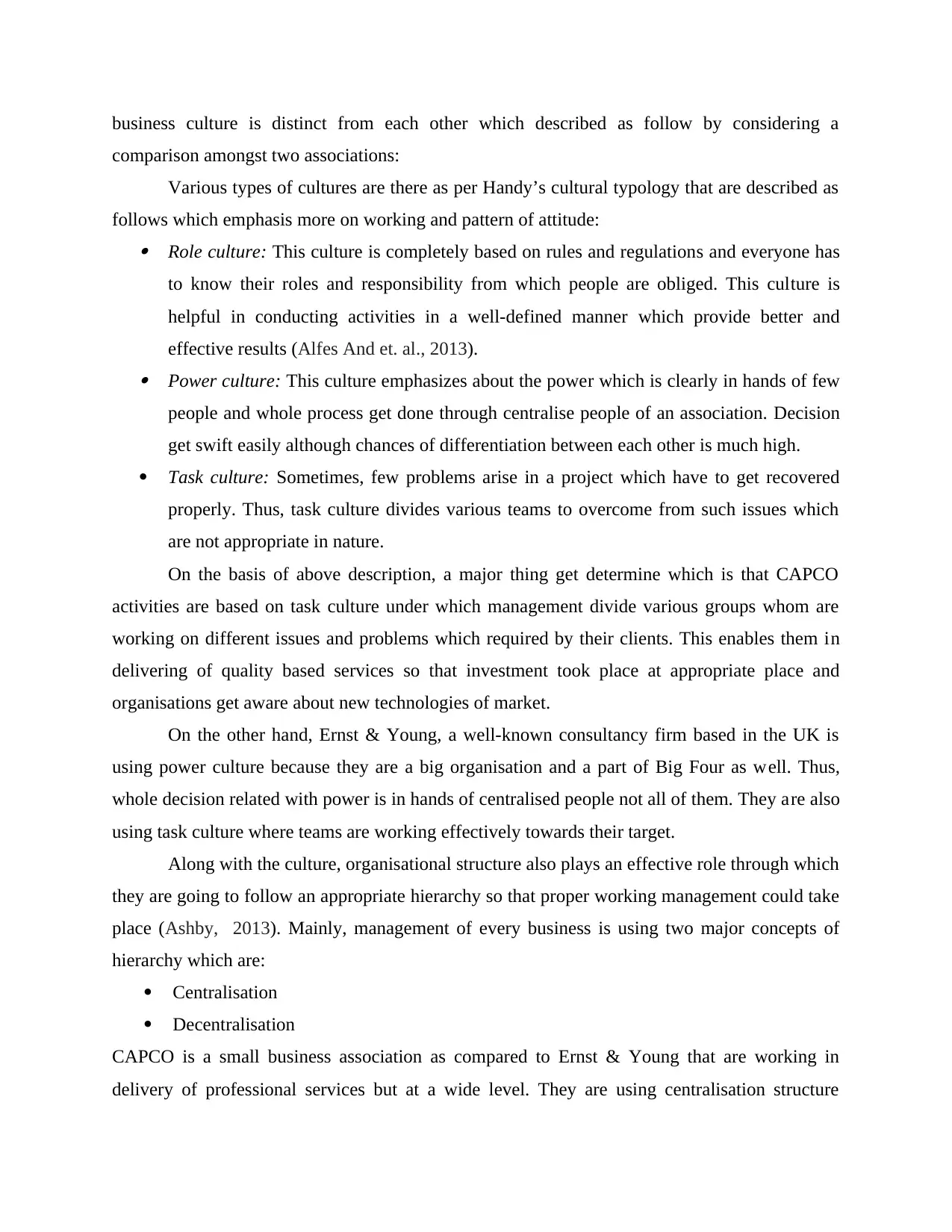
business culture is distinct from each other which described as follow by considering a
comparison amongst two associations:
Various types of cultures are there as per Handy’s cultural typology that are described as
follows which emphasis more on working and pattern of attitude: Role culture: This culture is completely based on rules and regulations and everyone has
to know their roles and responsibility from which people are obliged. This culture is
helpful in conducting activities in a well-defined manner which provide better and
effective results (Alfes And et. al., 2013). Power culture: This culture emphasizes about the power which is clearly in hands of few
people and whole process get done through centralise people of an association. Decision
get swift easily although chances of differentiation between each other is much high.
Task culture: Sometimes, few problems arise in a project which have to get recovered
properly. Thus, task culture divides various teams to overcome from such issues which
are not appropriate in nature.
On the basis of above description, a major thing get determine which is that CAPCO
activities are based on task culture under which management divide various groups whom are
working on different issues and problems which required by their clients. This enables them in
delivering of quality based services so that investment took place at appropriate place and
organisations get aware about new technologies of market.
On the other hand, Ernst & Young, a well-known consultancy firm based in the UK is
using power culture because they are a big organisation and a part of Big Four as well. Thus,
whole decision related with power is in hands of centralised people not all of them. They are also
using task culture where teams are working effectively towards their target.
Along with the culture, organisational structure also plays an effective role through which
they are going to follow an appropriate hierarchy so that proper working management could take
place (Ashby, 2013). Mainly, management of every business is using two major concepts of
hierarchy which are:
Centralisation
Decentralisation
CAPCO is a small business association as compared to Ernst & Young that are working in
delivery of professional services but at a wide level. They are using centralisation structure
comparison amongst two associations:
Various types of cultures are there as per Handy’s cultural typology that are described as
follows which emphasis more on working and pattern of attitude: Role culture: This culture is completely based on rules and regulations and everyone has
to know their roles and responsibility from which people are obliged. This culture is
helpful in conducting activities in a well-defined manner which provide better and
effective results (Alfes And et. al., 2013). Power culture: This culture emphasizes about the power which is clearly in hands of few
people and whole process get done through centralise people of an association. Decision
get swift easily although chances of differentiation between each other is much high.
Task culture: Sometimes, few problems arise in a project which have to get recovered
properly. Thus, task culture divides various teams to overcome from such issues which
are not appropriate in nature.
On the basis of above description, a major thing get determine which is that CAPCO
activities are based on task culture under which management divide various groups whom are
working on different issues and problems which required by their clients. This enables them in
delivering of quality based services so that investment took place at appropriate place and
organisations get aware about new technologies of market.
On the other hand, Ernst & Young, a well-known consultancy firm based in the UK is
using power culture because they are a big organisation and a part of Big Four as well. Thus,
whole decision related with power is in hands of centralised people not all of them. They are also
using task culture where teams are working effectively towards their target.
Along with the culture, organisational structure also plays an effective role through which
they are going to follow an appropriate hierarchy so that proper working management could take
place (Ashby, 2013). Mainly, management of every business is using two major concepts of
hierarchy which are:
Centralisation
Decentralisation
CAPCO is a small business association as compared to Ernst & Young that are working in
delivery of professional services but at a wide level. They are using centralisation structure
Paraphrase This Document
Need a fresh take? Get an instant paraphrase of this document with our AI Paraphraser
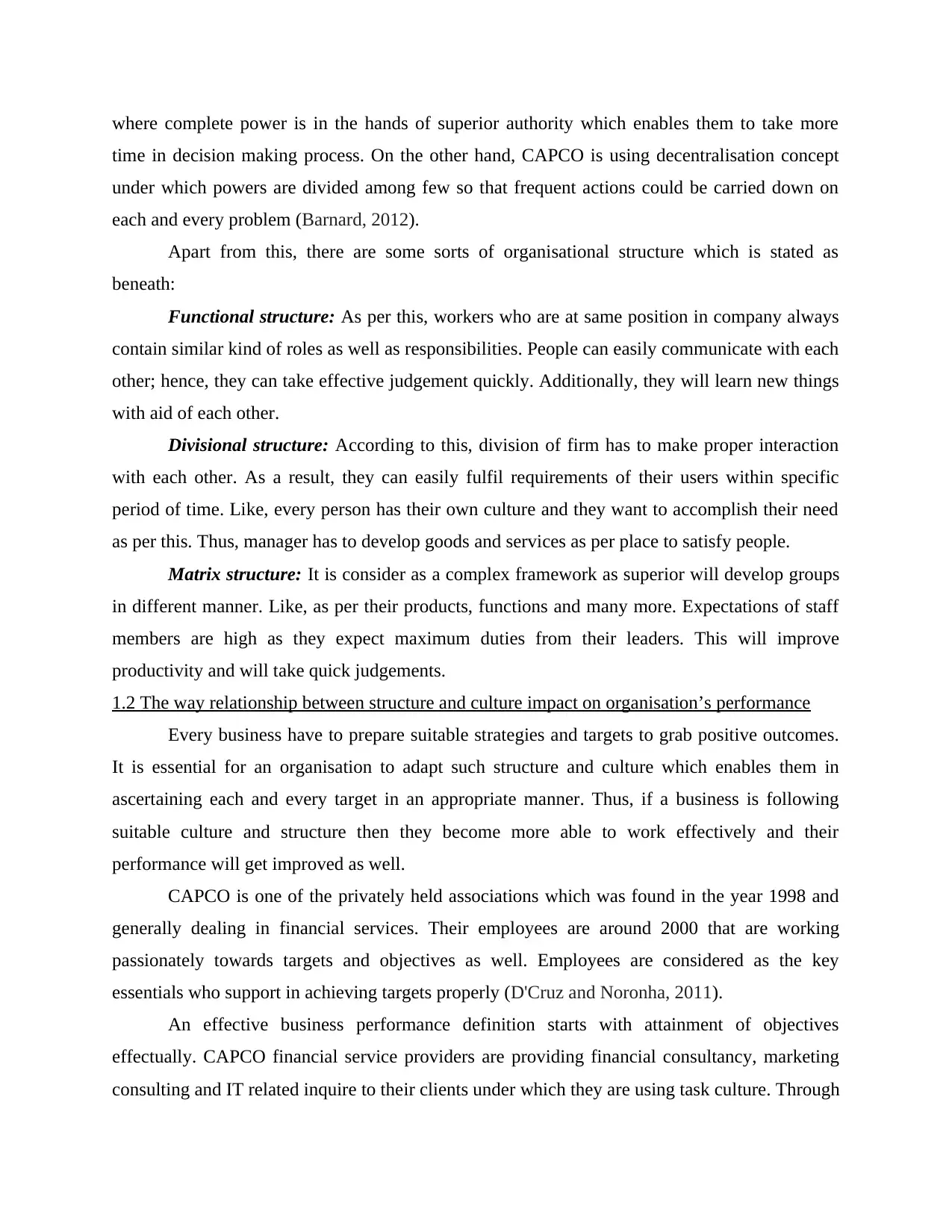
where complete power is in the hands of superior authority which enables them to take more
time in decision making process. On the other hand, CAPCO is using decentralisation concept
under which powers are divided among few so that frequent actions could be carried down on
each and every problem (Barnard, 2012).
Apart from this, there are some sorts of organisational structure which is stated as
beneath:
Functional structure: As per this, workers who are at same position in company always
contain similar kind of roles as well as responsibilities. People can easily communicate with each
other; hence, they can take effective judgement quickly. Additionally, they will learn new things
with aid of each other.
Divisional structure: According to this, division of firm has to make proper interaction
with each other. As a result, they can easily fulfil requirements of their users within specific
period of time. Like, every person has their own culture and they want to accomplish their need
as per this. Thus, manager has to develop goods and services as per place to satisfy people.
Matrix structure: It is consider as a complex framework as superior will develop groups
in different manner. Like, as per their products, functions and many more. Expectations of staff
members are high as they expect maximum duties from their leaders. This will improve
productivity and will take quick judgements.
1.2 The way relationship between structure and culture impact on organisation’s performance
Every business have to prepare suitable strategies and targets to grab positive outcomes.
It is essential for an organisation to adapt such structure and culture which enables them in
ascertaining each and every target in an appropriate manner. Thus, if a business is following
suitable culture and structure then they become more able to work effectively and their
performance will get improved as well.
CAPCO is one of the privately held associations which was found in the year 1998 and
generally dealing in financial services. Their employees are around 2000 that are working
passionately towards targets and objectives as well. Employees are considered as the key
essentials who support in achieving targets properly (D'Cruz and Noronha, 2011).
An effective business performance definition starts with attainment of objectives
effectually. CAPCO financial service providers are providing financial consultancy, marketing
consulting and IT related inquire to their clients under which they are using task culture. Through
time in decision making process. On the other hand, CAPCO is using decentralisation concept
under which powers are divided among few so that frequent actions could be carried down on
each and every problem (Barnard, 2012).
Apart from this, there are some sorts of organisational structure which is stated as
beneath:
Functional structure: As per this, workers who are at same position in company always
contain similar kind of roles as well as responsibilities. People can easily communicate with each
other; hence, they can take effective judgement quickly. Additionally, they will learn new things
with aid of each other.
Divisional structure: According to this, division of firm has to make proper interaction
with each other. As a result, they can easily fulfil requirements of their users within specific
period of time. Like, every person has their own culture and they want to accomplish their need
as per this. Thus, manager has to develop goods and services as per place to satisfy people.
Matrix structure: It is consider as a complex framework as superior will develop groups
in different manner. Like, as per their products, functions and many more. Expectations of staff
members are high as they expect maximum duties from their leaders. This will improve
productivity and will take quick judgements.
1.2 The way relationship between structure and culture impact on organisation’s performance
Every business have to prepare suitable strategies and targets to grab positive outcomes.
It is essential for an organisation to adapt such structure and culture which enables them in
ascertaining each and every target in an appropriate manner. Thus, if a business is following
suitable culture and structure then they become more able to work effectively and their
performance will get improved as well.
CAPCO is one of the privately held associations which was found in the year 1998 and
generally dealing in financial services. Their employees are around 2000 that are working
passionately towards targets and objectives as well. Employees are considered as the key
essentials who support in achieving targets properly (D'Cruz and Noronha, 2011).
An effective business performance definition starts with attainment of objectives
effectually. CAPCO financial service providers are providing financial consultancy, marketing
consulting and IT related inquire to their clients under which they are using task culture. Through
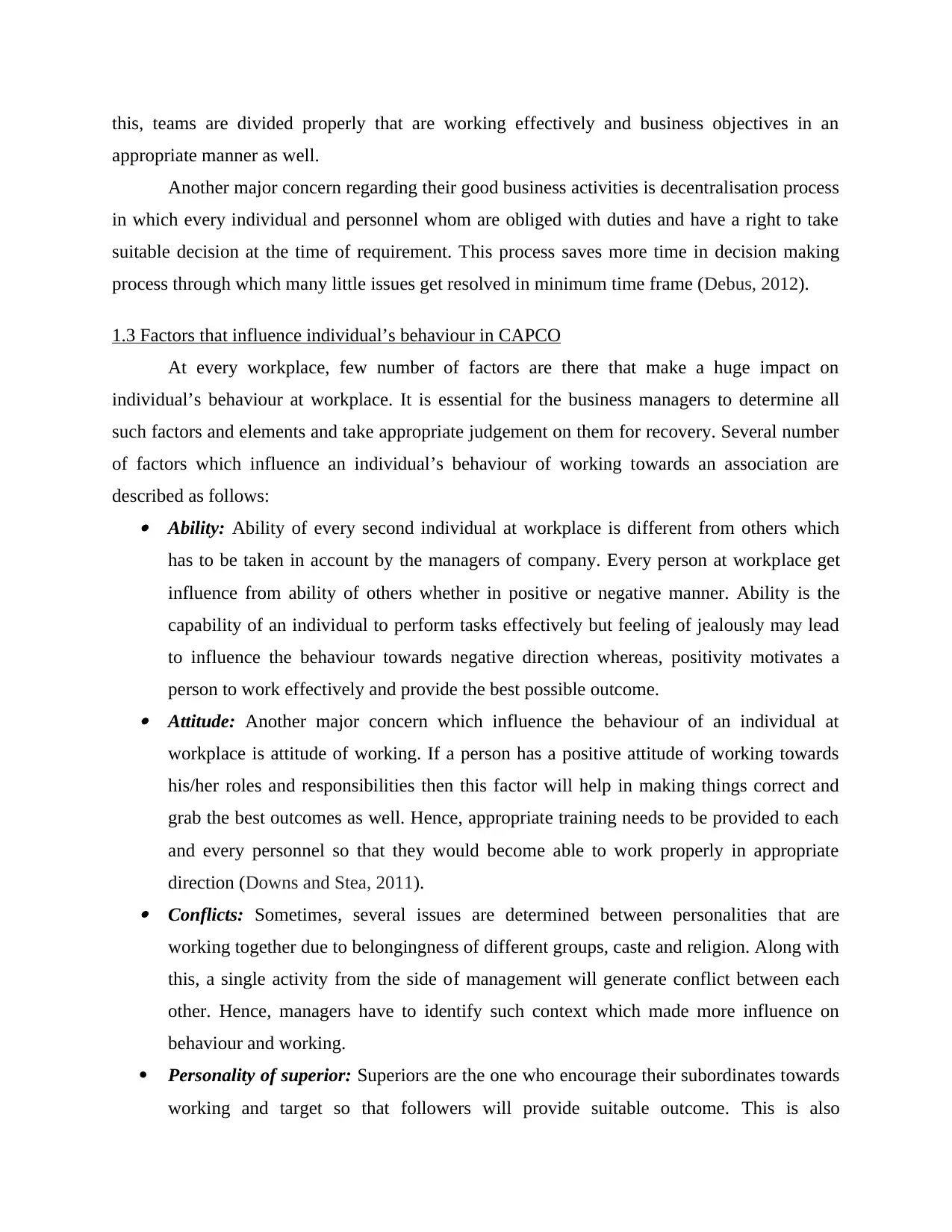
this, teams are divided properly that are working effectively and business objectives in an
appropriate manner as well.
Another major concern regarding their good business activities is decentralisation process
in which every individual and personnel whom are obliged with duties and have a right to take
suitable decision at the time of requirement. This process saves more time in decision making
process through which many little issues get resolved in minimum time frame (Debus, 2012).
1.3 Factors that influence individual’s behaviour in CAPCO
At every workplace, few number of factors are there that make a huge impact on
individual’s behaviour at workplace. It is essential for the business managers to determine all
such factors and elements and take appropriate judgement on them for recovery. Several number
of factors which influence an individual’s behaviour of working towards an association are
described as follows: Ability: Ability of every second individual at workplace is different from others which
has to be taken in account by the managers of company. Every person at workplace get
influence from ability of others whether in positive or negative manner. Ability is the
capability of an individual to perform tasks effectively but feeling of jealously may lead
to influence the behaviour towards negative direction whereas, positivity motivates a
person to work effectively and provide the best possible outcome. Attitude: Another major concern which influence the behaviour of an individual at
workplace is attitude of working. If a person has a positive attitude of working towards
his/her roles and responsibilities then this factor will help in making things correct and
grab the best outcomes as well. Hence, appropriate training needs to be provided to each
and every personnel so that they would become able to work properly in appropriate
direction (Downs and Stea, 2011). Conflicts: Sometimes, several issues are determined between personalities that are
working together due to belongingness of different groups, caste and religion. Along with
this, a single activity from the side of management will generate conflict between each
other. Hence, managers have to identify such context which made more influence on
behaviour and working.
Personality of superior: Superiors are the one who encourage their subordinates towards
working and target so that followers will provide suitable outcome. This is also
appropriate manner as well.
Another major concern regarding their good business activities is decentralisation process
in which every individual and personnel whom are obliged with duties and have a right to take
suitable decision at the time of requirement. This process saves more time in decision making
process through which many little issues get resolved in minimum time frame (Debus, 2012).
1.3 Factors that influence individual’s behaviour in CAPCO
At every workplace, few number of factors are there that make a huge impact on
individual’s behaviour at workplace. It is essential for the business managers to determine all
such factors and elements and take appropriate judgement on them for recovery. Several number
of factors which influence an individual’s behaviour of working towards an association are
described as follows: Ability: Ability of every second individual at workplace is different from others which
has to be taken in account by the managers of company. Every person at workplace get
influence from ability of others whether in positive or negative manner. Ability is the
capability of an individual to perform tasks effectively but feeling of jealously may lead
to influence the behaviour towards negative direction whereas, positivity motivates a
person to work effectively and provide the best possible outcome. Attitude: Another major concern which influence the behaviour of an individual at
workplace is attitude of working. If a person has a positive attitude of working towards
his/her roles and responsibilities then this factor will help in making things correct and
grab the best outcomes as well. Hence, appropriate training needs to be provided to each
and every personnel so that they would become able to work properly in appropriate
direction (Downs and Stea, 2011). Conflicts: Sometimes, several issues are determined between personalities that are
working together due to belongingness of different groups, caste and religion. Along with
this, a single activity from the side of management will generate conflict between each
other. Hence, managers have to identify such context which made more influence on
behaviour and working.
Personality of superior: Superiors are the one who encourage their subordinates towards
working and target so that followers will provide suitable outcome. This is also
⊘ This is a preview!⊘
Do you want full access?
Subscribe today to unlock all pages.

Trusted by 1+ million students worldwide
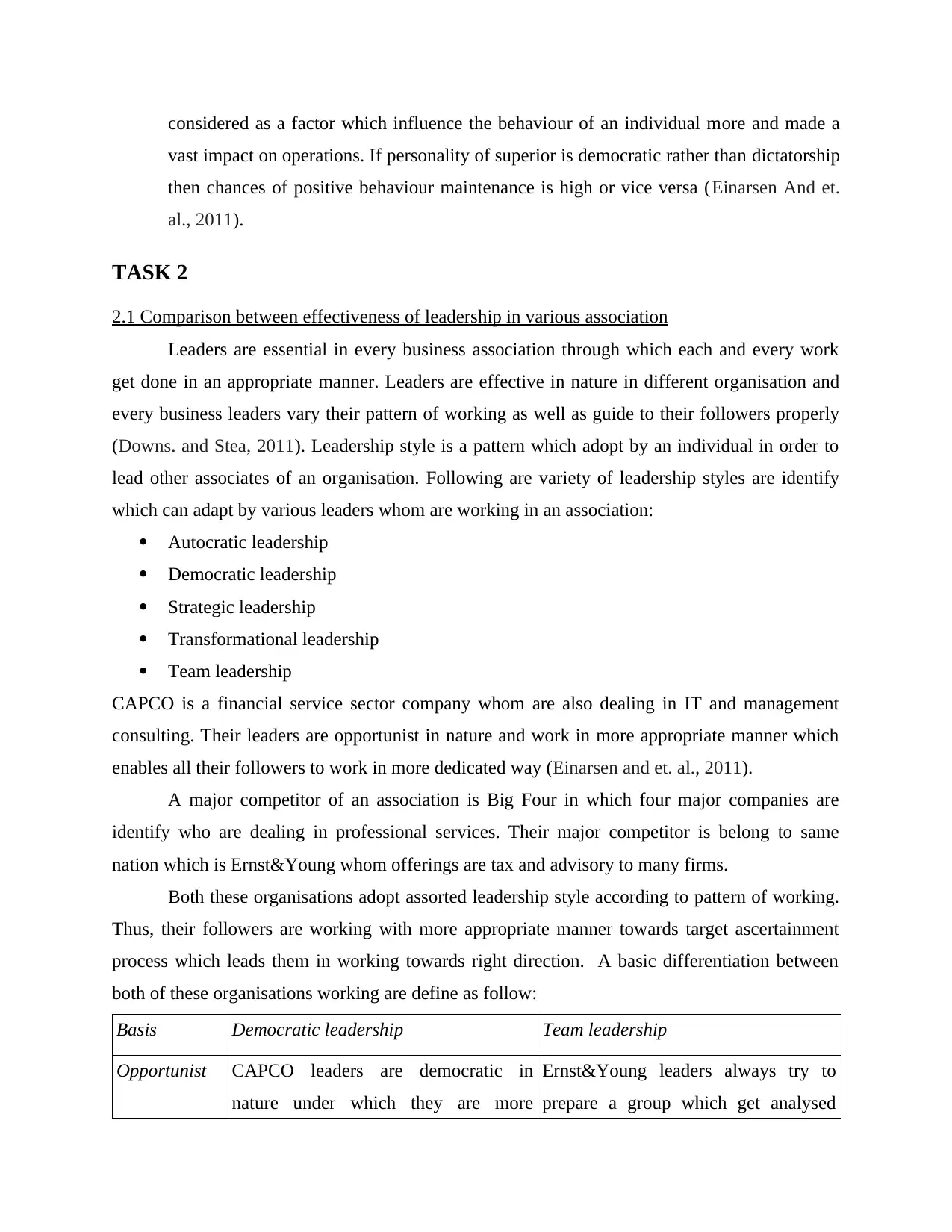
considered as a factor which influence the behaviour of an individual more and made a
vast impact on operations. If personality of superior is democratic rather than dictatorship
then chances of positive behaviour maintenance is high or vice versa (Einarsen And et.
al., 2011).
TASK 2
2.1 Comparison between effectiveness of leadership in various association
Leaders are essential in every business association through which each and every work
get done in an appropriate manner. Leaders are effective in nature in different organisation and
every business leaders vary their pattern of working as well as guide to their followers properly
(Downs. and Stea, 2011). Leadership style is a pattern which adopt by an individual in order to
lead other associates of an organisation. Following are variety of leadership styles are identify
which can adapt by various leaders whom are working in an association:
Autocratic leadership
Democratic leadership
Strategic leadership
Transformational leadership
Team leadership
CAPCO is a financial service sector company whom are also dealing in IT and management
consulting. Their leaders are opportunist in nature and work in more appropriate manner which
enables all their followers to work in more dedicated way (Einarsen and et. al., 2011).
A major competitor of an association is Big Four in which four major companies are
identify who are dealing in professional services. Their major competitor is belong to same
nation which is Ernst&Young whom offerings are tax and advisory to many firms.
Both these organisations adopt assorted leadership style according to pattern of working.
Thus, their followers are working with more appropriate manner towards target ascertainment
process which leads them in working towards right direction. A basic differentiation between
both of these organisations working are define as follow:
Basis Democratic leadership Team leadership
Opportunist CAPCO leaders are democratic in
nature under which they are more
Ernst&Young leaders always try to
prepare a group which get analysed
vast impact on operations. If personality of superior is democratic rather than dictatorship
then chances of positive behaviour maintenance is high or vice versa (Einarsen And et.
al., 2011).
TASK 2
2.1 Comparison between effectiveness of leadership in various association
Leaders are essential in every business association through which each and every work
get done in an appropriate manner. Leaders are effective in nature in different organisation and
every business leaders vary their pattern of working as well as guide to their followers properly
(Downs. and Stea, 2011). Leadership style is a pattern which adopt by an individual in order to
lead other associates of an organisation. Following are variety of leadership styles are identify
which can adapt by various leaders whom are working in an association:
Autocratic leadership
Democratic leadership
Strategic leadership
Transformational leadership
Team leadership
CAPCO is a financial service sector company whom are also dealing in IT and management
consulting. Their leaders are opportunist in nature and work in more appropriate manner which
enables all their followers to work in more dedicated way (Einarsen and et. al., 2011).
A major competitor of an association is Big Four in which four major companies are
identify who are dealing in professional services. Their major competitor is belong to same
nation which is Ernst&Young whom offerings are tax and advisory to many firms.
Both these organisations adopt assorted leadership style according to pattern of working.
Thus, their followers are working with more appropriate manner towards target ascertainment
process which leads them in working towards right direction. A basic differentiation between
both of these organisations working are define as follow:
Basis Democratic leadership Team leadership
Opportunist CAPCO leaders are democratic in
nature under which they are more
Ernst&Young leaders always try to
prepare a group which get analysed
Paraphrase This Document
Need a fresh take? Get an instant paraphrase of this document with our AI Paraphraser
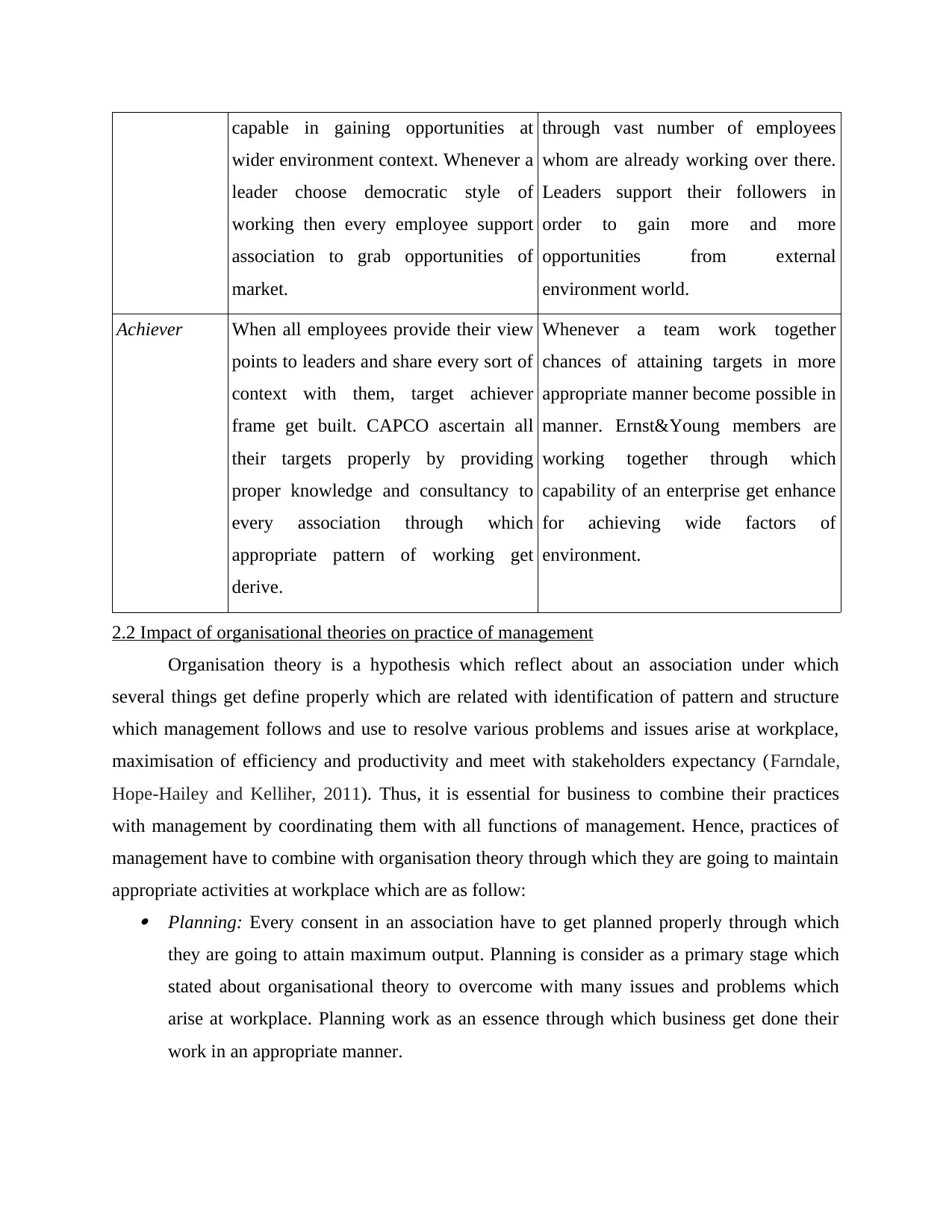
capable in gaining opportunities at
wider environment context. Whenever a
leader choose democratic style of
working then every employee support
association to grab opportunities of
market.
through vast number of employees
whom are already working over there.
Leaders support their followers in
order to gain more and more
opportunities from external
environment world.
Achiever When all employees provide their view
points to leaders and share every sort of
context with them, target achiever
frame get built. CAPCO ascertain all
their targets properly by providing
proper knowledge and consultancy to
every association through which
appropriate pattern of working get
derive.
Whenever a team work together
chances of attaining targets in more
appropriate manner become possible in
manner. Ernst&Young members are
working together through which
capability of an enterprise get enhance
for achieving wide factors of
environment.
2.2 Impact of organisational theories on practice of management
Organisation theory is a hypothesis which reflect about an association under which
several things get define properly which are related with identification of pattern and structure
which management follows and use to resolve various problems and issues arise at workplace,
maximisation of efficiency and productivity and meet with stakeholders expectancy (Farndale,
Hope-Hailey and Kelliher, 2011). Thus, it is essential for business to combine their practices
with management by coordinating them with all functions of management. Hence, practices of
management have to combine with organisation theory through which they are going to maintain
appropriate activities at workplace which are as follow: Planning: Every consent in an association have to get planned properly through which
they are going to attain maximum output. Planning is consider as a primary stage which
stated about organisational theory to overcome with many issues and problems which
arise at workplace. Planning work as an essence through which business get done their
work in an appropriate manner.
wider environment context. Whenever a
leader choose democratic style of
working then every employee support
association to grab opportunities of
market.
through vast number of employees
whom are already working over there.
Leaders support their followers in
order to gain more and more
opportunities from external
environment world.
Achiever When all employees provide their view
points to leaders and share every sort of
context with them, target achiever
frame get built. CAPCO ascertain all
their targets properly by providing
proper knowledge and consultancy to
every association through which
appropriate pattern of working get
derive.
Whenever a team work together
chances of attaining targets in more
appropriate manner become possible in
manner. Ernst&Young members are
working together through which
capability of an enterprise get enhance
for achieving wide factors of
environment.
2.2 Impact of organisational theories on practice of management
Organisation theory is a hypothesis which reflect about an association under which
several things get define properly which are related with identification of pattern and structure
which management follows and use to resolve various problems and issues arise at workplace,
maximisation of efficiency and productivity and meet with stakeholders expectancy (Farndale,
Hope-Hailey and Kelliher, 2011). Thus, it is essential for business to combine their practices
with management by coordinating them with all functions of management. Hence, practices of
management have to combine with organisation theory through which they are going to maintain
appropriate activities at workplace which are as follow: Planning: Every consent in an association have to get planned properly through which
they are going to attain maximum output. Planning is consider as a primary stage which
stated about organisational theory to overcome with many issues and problems which
arise at workplace. Planning work as an essence through which business get done their
work in an appropriate manner.
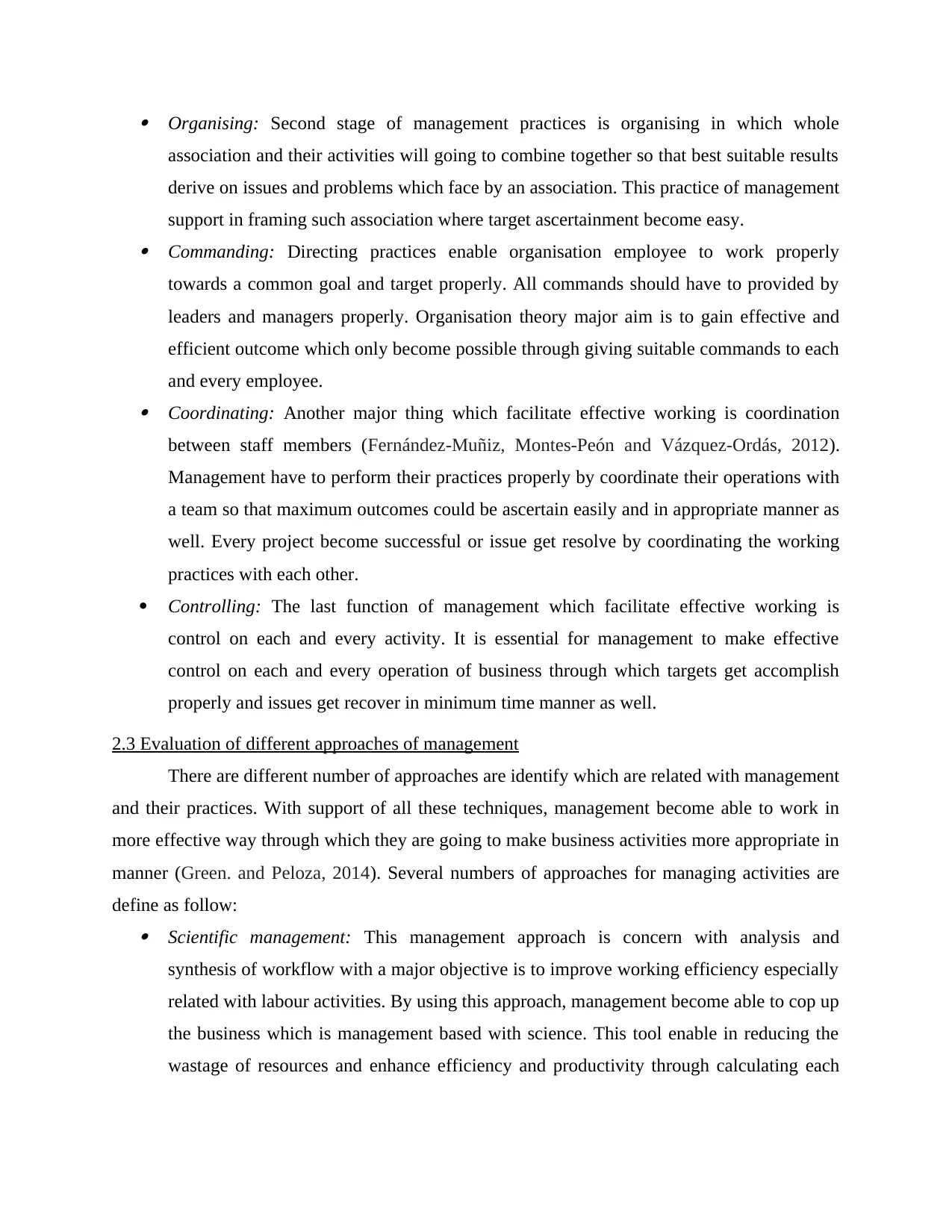
Organising: Second stage of management practices is organising in which whole
association and their activities will going to combine together so that best suitable results
derive on issues and problems which face by an association. This practice of management
support in framing such association where target ascertainment become easy. Commanding: Directing practices enable organisation employee to work properly
towards a common goal and target properly. All commands should have to provided by
leaders and managers properly. Organisation theory major aim is to gain effective and
efficient outcome which only become possible through giving suitable commands to each
and every employee. Coordinating: Another major thing which facilitate effective working is coordination
between staff members (Fernández-Muñiz, Montes-Peón and Vázquez-Ordás, 2012).
Management have to perform their practices properly by coordinate their operations with
a team so that maximum outcomes could be ascertain easily and in appropriate manner as
well. Every project become successful or issue get resolve by coordinating the working
practices with each other.
Controlling: The last function of management which facilitate effective working is
control on each and every activity. It is essential for management to make effective
control on each and every operation of business through which targets get accomplish
properly and issues get recover in minimum time manner as well.
2.3 Evaluation of different approaches of management
There are different number of approaches are identify which are related with management
and their practices. With support of all these techniques, management become able to work in
more effective way through which they are going to make business activities more appropriate in
manner (Green. and Peloza, 2014). Several numbers of approaches for managing activities are
define as follow: Scientific management: This management approach is concern with analysis and
synthesis of workflow with a major objective is to improve working efficiency especially
related with labour activities. By using this approach, management become able to cop up
the business which is management based with science. This tool enable in reducing the
wastage of resources and enhance efficiency and productivity through calculating each
association and their activities will going to combine together so that best suitable results
derive on issues and problems which face by an association. This practice of management
support in framing such association where target ascertainment become easy. Commanding: Directing practices enable organisation employee to work properly
towards a common goal and target properly. All commands should have to provided by
leaders and managers properly. Organisation theory major aim is to gain effective and
efficient outcome which only become possible through giving suitable commands to each
and every employee. Coordinating: Another major thing which facilitate effective working is coordination
between staff members (Fernández-Muñiz, Montes-Peón and Vázquez-Ordás, 2012).
Management have to perform their practices properly by coordinate their operations with
a team so that maximum outcomes could be ascertain easily and in appropriate manner as
well. Every project become successful or issue get resolve by coordinating the working
practices with each other.
Controlling: The last function of management which facilitate effective working is
control on each and every activity. It is essential for management to make effective
control on each and every operation of business through which targets get accomplish
properly and issues get recover in minimum time manner as well.
2.3 Evaluation of different approaches of management
There are different number of approaches are identify which are related with management
and their practices. With support of all these techniques, management become able to work in
more effective way through which they are going to make business activities more appropriate in
manner (Green. and Peloza, 2014). Several numbers of approaches for managing activities are
define as follow: Scientific management: This management approach is concern with analysis and
synthesis of workflow with a major objective is to improve working efficiency especially
related with labour activities. By using this approach, management become able to cop up
the business which is management based with science. This tool enable in reducing the
wastage of resources and enhance efficiency and productivity through calculating each
⊘ This is a preview!⊘
Do you want full access?
Subscribe today to unlock all pages.

Trusted by 1+ million students worldwide
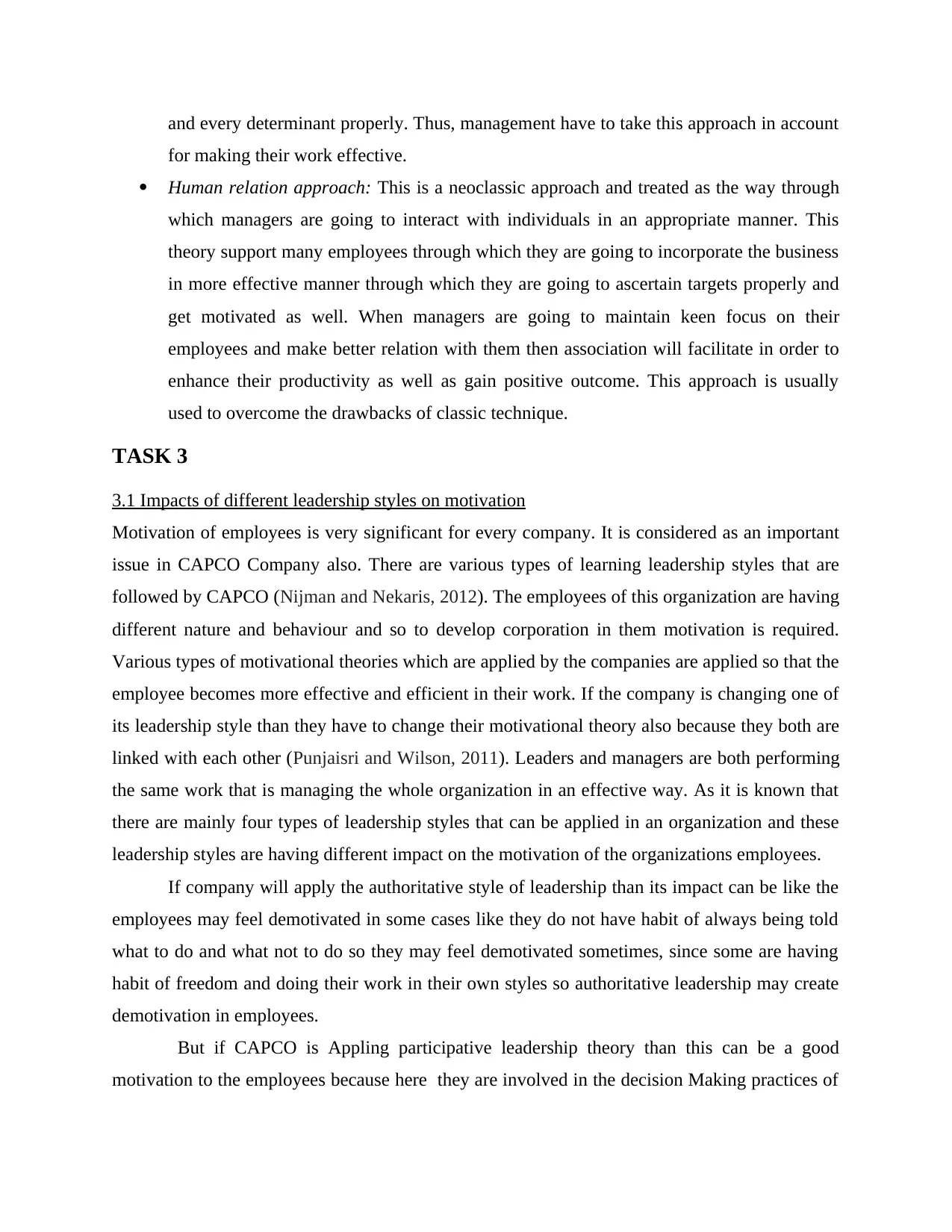
and every determinant properly. Thus, management have to take this approach in account
for making their work effective.
Human relation approach: This is a neoclassic approach and treated as the way through
which managers are going to interact with individuals in an appropriate manner. This
theory support many employees through which they are going to incorporate the business
in more effective manner through which they are going to ascertain targets properly and
get motivated as well. When managers are going to maintain keen focus on their
employees and make better relation with them then association will facilitate in order to
enhance their productivity as well as gain positive outcome. This approach is usually
used to overcome the drawbacks of classic technique.
TASK 3
3.1 Impacts of different leadership styles on motivation
Motivation of employees is very significant for every company. It is considered as an important
issue in CAPCO Company also. There are various types of learning leadership styles that are
followed by CAPCO (Nijman and Nekaris, 2012). The employees of this organization are having
different nature and behaviour and so to develop corporation in them motivation is required.
Various types of motivational theories which are applied by the companies are applied so that the
employee becomes more effective and efficient in their work. If the company is changing one of
its leadership style than they have to change their motivational theory also because they both are
linked with each other (Punjaisri and Wilson, 2011). Leaders and managers are both performing
the same work that is managing the whole organization in an effective way. As it is known that
there are mainly four types of leadership styles that can be applied in an organization and these
leadership styles are having different impact on the motivation of the organizations employees.
If company will apply the authoritative style of leadership than its impact can be like the
employees may feel demotivated in some cases like they do not have habit of always being told
what to do and what not to do so they may feel demotivated sometimes, since some are having
habit of freedom and doing their work in their own styles so authoritative leadership may create
demotivation in employees.
But if CAPCO is Appling participative leadership theory than this can be a good
motivation to the employees because here they are involved in the decision Making practices of
for making their work effective.
Human relation approach: This is a neoclassic approach and treated as the way through
which managers are going to interact with individuals in an appropriate manner. This
theory support many employees through which they are going to incorporate the business
in more effective manner through which they are going to ascertain targets properly and
get motivated as well. When managers are going to maintain keen focus on their
employees and make better relation with them then association will facilitate in order to
enhance their productivity as well as gain positive outcome. This approach is usually
used to overcome the drawbacks of classic technique.
TASK 3
3.1 Impacts of different leadership styles on motivation
Motivation of employees is very significant for every company. It is considered as an important
issue in CAPCO Company also. There are various types of learning leadership styles that are
followed by CAPCO (Nijman and Nekaris, 2012). The employees of this organization are having
different nature and behaviour and so to develop corporation in them motivation is required.
Various types of motivational theories which are applied by the companies are applied so that the
employee becomes more effective and efficient in their work. If the company is changing one of
its leadership style than they have to change their motivational theory also because they both are
linked with each other (Punjaisri and Wilson, 2011). Leaders and managers are both performing
the same work that is managing the whole organization in an effective way. As it is known that
there are mainly four types of leadership styles that can be applied in an organization and these
leadership styles are having different impact on the motivation of the organizations employees.
If company will apply the authoritative style of leadership than its impact can be like the
employees may feel demotivated in some cases like they do not have habit of always being told
what to do and what not to do so they may feel demotivated sometimes, since some are having
habit of freedom and doing their work in their own styles so authoritative leadership may create
demotivation in employees.
But if CAPCO is Appling participative leadership theory than this can be a good
motivation to the employees because here they are involved in the decision Making practices of
Paraphrase This Document
Need a fresh take? Get an instant paraphrase of this document with our AI Paraphraser
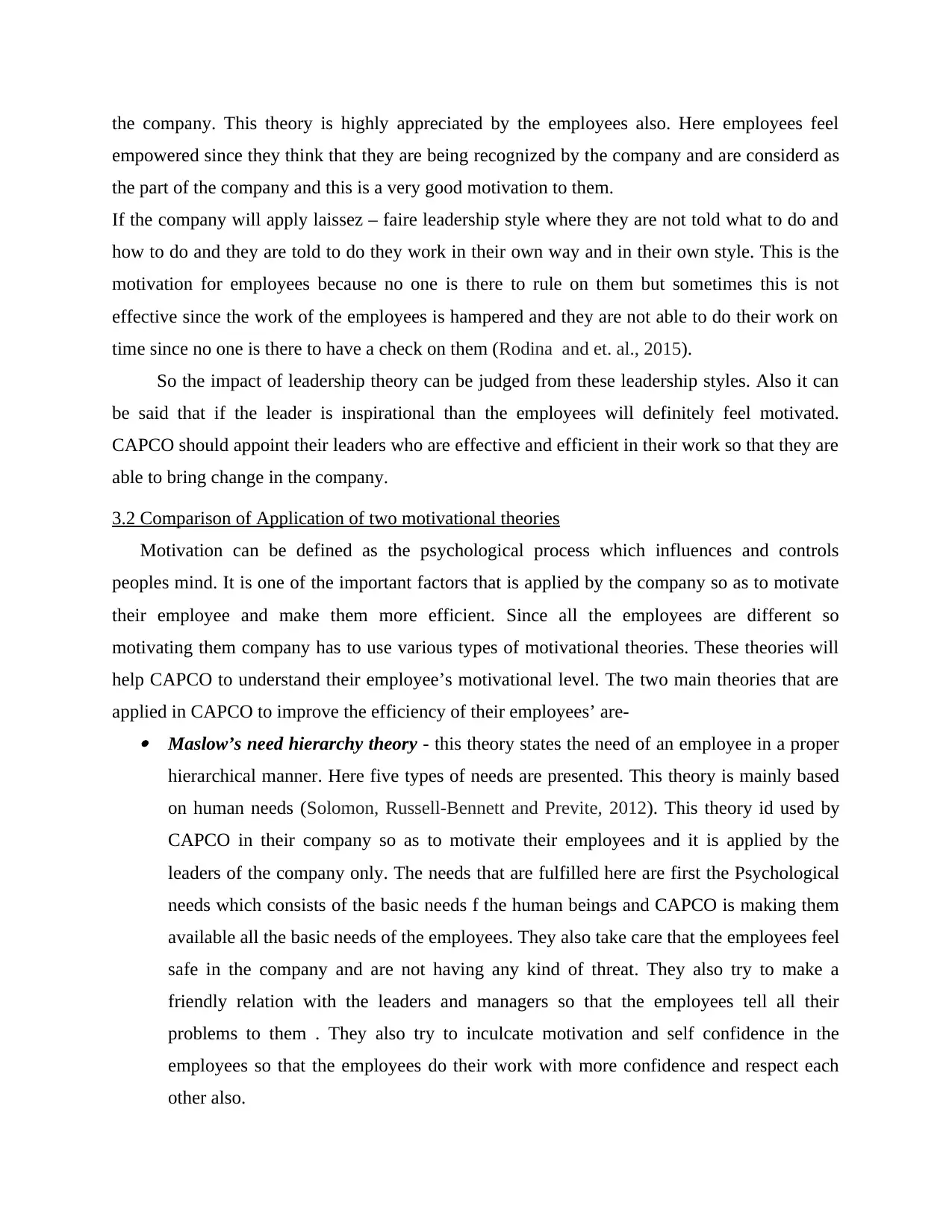
the company. This theory is highly appreciated by the employees also. Here employees feel
empowered since they think that they are being recognized by the company and are considerd as
the part of the company and this is a very good motivation to them.
If the company will apply laissez – faire leadership style where they are not told what to do and
how to do and they are told to do they work in their own way and in their own style. This is the
motivation for employees because no one is there to rule on them but sometimes this is not
effective since the work of the employees is hampered and they are not able to do their work on
time since no one is there to have a check on them (Rodina and et. al., 2015).
So the impact of leadership theory can be judged from these leadership styles. Also it can
be said that if the leader is inspirational than the employees will definitely feel motivated.
CAPCO should appoint their leaders who are effective and efficient in their work so that they are
able to bring change in the company.
3.2 Comparison of Application of two motivational theories
Motivation can be defined as the psychological process which influences and controls
peoples mind. It is one of the important factors that is applied by the company so as to motivate
their employee and make them more efficient. Since all the employees are different so
motivating them company has to use various types of motivational theories. These theories will
help CAPCO to understand their employee’s motivational level. The two main theories that are
applied in CAPCO to improve the efficiency of their employees’ are- Maslow’s need hierarchy theory - this theory states the need of an employee in a proper
hierarchical manner. Here five types of needs are presented. This theory is mainly based
on human needs (Solomon, Russell-Bennett and Previte, 2012). This theory id used by
CAPCO in their company so as to motivate their employees and it is applied by the
leaders of the company only. The needs that are fulfilled here are first the Psychological
needs which consists of the basic needs f the human beings and CAPCO is making them
available all the basic needs of the employees. They also take care that the employees feel
safe in the company and are not having any kind of threat. They also try to make a
friendly relation with the leaders and managers so that the employees tell all their
problems to them . They also try to inculcate motivation and self confidence in the
employees so that the employees do their work with more confidence and respect each
other also.
empowered since they think that they are being recognized by the company and are considerd as
the part of the company and this is a very good motivation to them.
If the company will apply laissez – faire leadership style where they are not told what to do and
how to do and they are told to do they work in their own way and in their own style. This is the
motivation for employees because no one is there to rule on them but sometimes this is not
effective since the work of the employees is hampered and they are not able to do their work on
time since no one is there to have a check on them (Rodina and et. al., 2015).
So the impact of leadership theory can be judged from these leadership styles. Also it can
be said that if the leader is inspirational than the employees will definitely feel motivated.
CAPCO should appoint their leaders who are effective and efficient in their work so that they are
able to bring change in the company.
3.2 Comparison of Application of two motivational theories
Motivation can be defined as the psychological process which influences and controls
peoples mind. It is one of the important factors that is applied by the company so as to motivate
their employee and make them more efficient. Since all the employees are different so
motivating them company has to use various types of motivational theories. These theories will
help CAPCO to understand their employee’s motivational level. The two main theories that are
applied in CAPCO to improve the efficiency of their employees’ are- Maslow’s need hierarchy theory - this theory states the need of an employee in a proper
hierarchical manner. Here five types of needs are presented. This theory is mainly based
on human needs (Solomon, Russell-Bennett and Previte, 2012). This theory id used by
CAPCO in their company so as to motivate their employees and it is applied by the
leaders of the company only. The needs that are fulfilled here are first the Psychological
needs which consists of the basic needs f the human beings and CAPCO is making them
available all the basic needs of the employees. They also take care that the employees feel
safe in the company and are not having any kind of threat. They also try to make a
friendly relation with the leaders and managers so that the employees tell all their
problems to them . They also try to inculcate motivation and self confidence in the
employees so that the employees do their work with more confidence and respect each
other also.
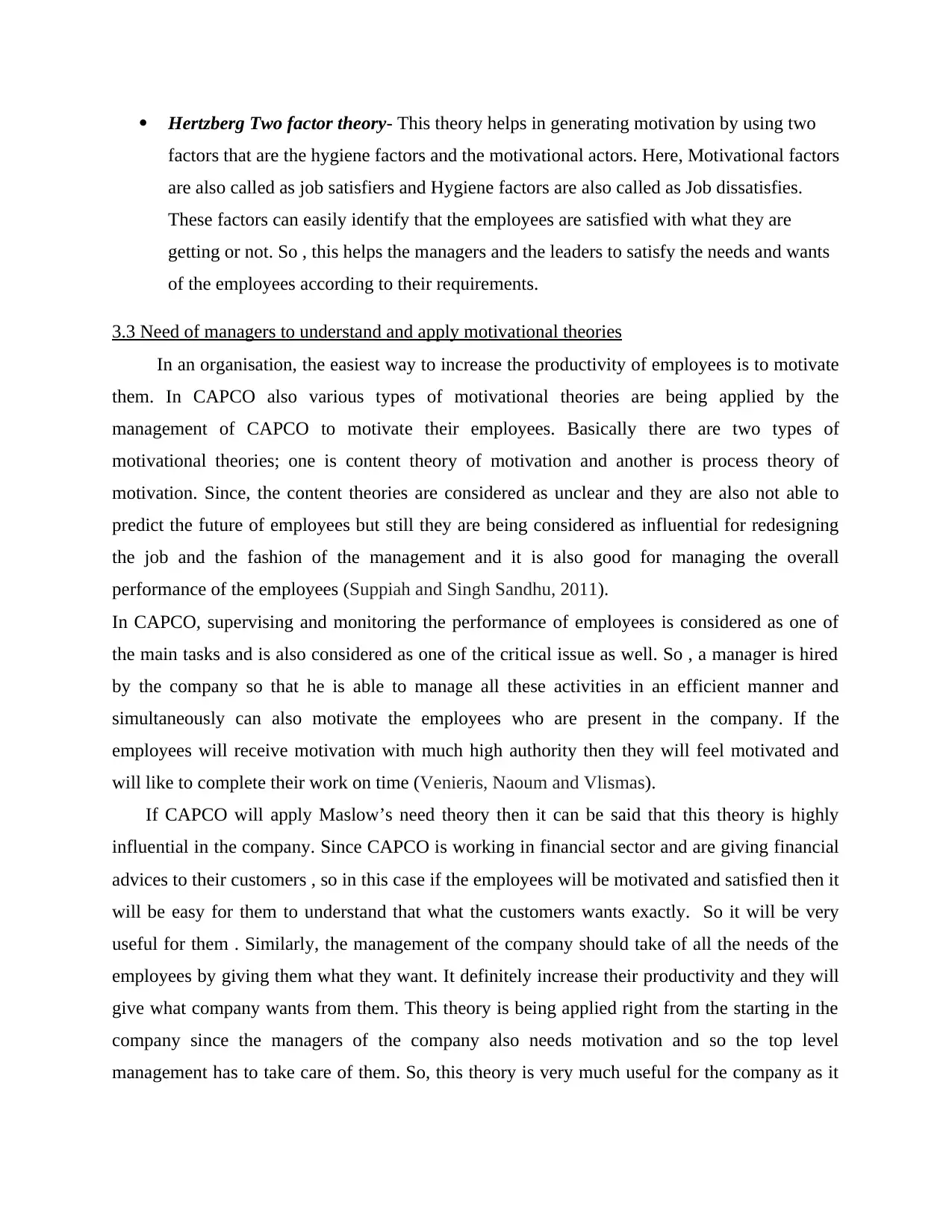
Hertzberg Two factor theory- This theory helps in generating motivation by using two
factors that are the hygiene factors and the motivational actors. Here, Motivational factors
are also called as job satisfiers and Hygiene factors are also called as Job dissatisfies.
These factors can easily identify that the employees are satisfied with what they are
getting or not. So , this helps the managers and the leaders to satisfy the needs and wants
of the employees according to their requirements.
3.3 Need of managers to understand and apply motivational theories
In an organisation, the easiest way to increase the productivity of employees is to motivate
them. In CAPCO also various types of motivational theories are being applied by the
management of CAPCO to motivate their employees. Basically there are two types of
motivational theories; one is content theory of motivation and another is process theory of
motivation. Since, the content theories are considered as unclear and they are also not able to
predict the future of employees but still they are being considered as influential for redesigning
the job and the fashion of the management and it is also good for managing the overall
performance of the employees (Suppiah and Singh Sandhu, 2011).
In CAPCO, supervising and monitoring the performance of employees is considered as one of
the main tasks and is also considered as one of the critical issue as well. So , a manager is hired
by the company so that he is able to manage all these activities in an efficient manner and
simultaneously can also motivate the employees who are present in the company. If the
employees will receive motivation with much high authority then they will feel motivated and
will like to complete their work on time (Venieris, Naoum and Vlismas).
If CAPCO will apply Maslow’s need theory then it can be said that this theory is highly
influential in the company. Since CAPCO is working in financial sector and are giving financial
advices to their customers , so in this case if the employees will be motivated and satisfied then it
will be easy for them to understand that what the customers wants exactly. So it will be very
useful for them . Similarly, the management of the company should take of all the needs of the
employees by giving them what they want. It definitely increase their productivity and they will
give what company wants from them. This theory is being applied right from the starting in the
company since the managers of the company also needs motivation and so the top level
management has to take care of them. So, this theory is very much useful for the company as it
factors that are the hygiene factors and the motivational actors. Here, Motivational factors
are also called as job satisfiers and Hygiene factors are also called as Job dissatisfies.
These factors can easily identify that the employees are satisfied with what they are
getting or not. So , this helps the managers and the leaders to satisfy the needs and wants
of the employees according to their requirements.
3.3 Need of managers to understand and apply motivational theories
In an organisation, the easiest way to increase the productivity of employees is to motivate
them. In CAPCO also various types of motivational theories are being applied by the
management of CAPCO to motivate their employees. Basically there are two types of
motivational theories; one is content theory of motivation and another is process theory of
motivation. Since, the content theories are considered as unclear and they are also not able to
predict the future of employees but still they are being considered as influential for redesigning
the job and the fashion of the management and it is also good for managing the overall
performance of the employees (Suppiah and Singh Sandhu, 2011).
In CAPCO, supervising and monitoring the performance of employees is considered as one of
the main tasks and is also considered as one of the critical issue as well. So , a manager is hired
by the company so that he is able to manage all these activities in an efficient manner and
simultaneously can also motivate the employees who are present in the company. If the
employees will receive motivation with much high authority then they will feel motivated and
will like to complete their work on time (Venieris, Naoum and Vlismas).
If CAPCO will apply Maslow’s need theory then it can be said that this theory is highly
influential in the company. Since CAPCO is working in financial sector and are giving financial
advices to their customers , so in this case if the employees will be motivated and satisfied then it
will be easy for them to understand that what the customers wants exactly. So it will be very
useful for them . Similarly, the management of the company should take of all the needs of the
employees by giving them what they want. It definitely increase their productivity and they will
give what company wants from them. This theory is being applied right from the starting in the
company since the managers of the company also needs motivation and so the top level
management has to take care of them. So, this theory is very much useful for the company as it
⊘ This is a preview!⊘
Do you want full access?
Subscribe today to unlock all pages.

Trusted by 1+ million students worldwide
1 out of 18
Related Documents
Your All-in-One AI-Powered Toolkit for Academic Success.
+13062052269
info@desklib.com
Available 24*7 on WhatsApp / Email
![[object Object]](/_next/static/media/star-bottom.7253800d.svg)
Unlock your academic potential
Copyright © 2020–2025 A2Z Services. All Rights Reserved. Developed and managed by ZUCOL.





